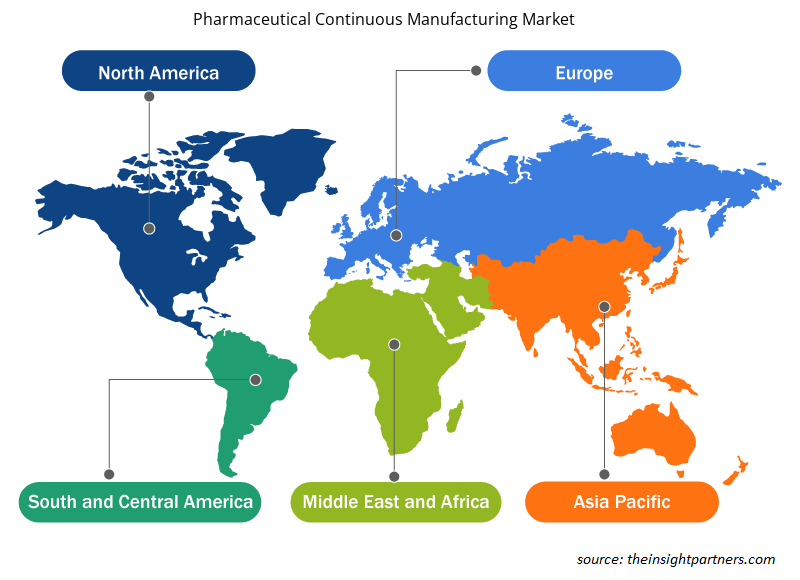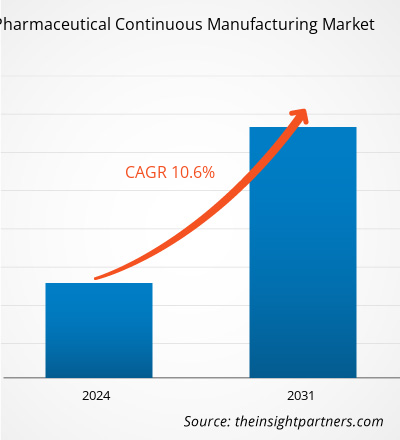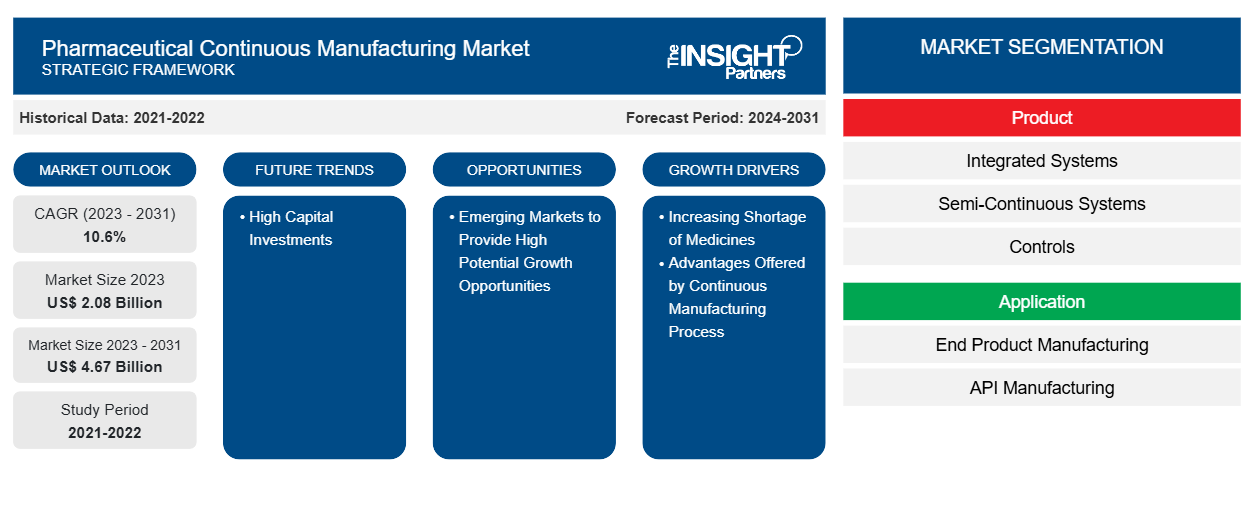医薬品連続製造市場規模は、2023 年の 20 億 8,000 万米ドルから 2031 年には 46 億 7,000 万米ドルに達すると予測されています。市場は 2023年から 2031 年にかけて 10.6% のCAGRを記録すると予想されています。規制当局からのサポートの拡大、医薬品製造手順に対する契約製造業者および社内製造業者による採用の増加、および連続製造に関連する利点は、市場の主要なトレンドであり続けると思われます。
医薬品連続製造市場分析
製薬会社は、競争上の優位性を獲得し、市場で先頭に立つために、革新的な製造技術に絶えず投資しており、それによって連続製造市場を牽引しています。連続製造により、製薬会社は生産プロセスをより細かく制御できるようになり、最終製品の品質向上と一貫性に役立ち、逸脱や無駄を減らし、やり直しの時間とリコール費用を節約できます。医薬品の連続製造により、最終製品の品質を向上させ、プロセス制御を強化し、リアルタイムのリリーステストが可能になります。欧州医薬品庁 ( EMA ) と米国食品医薬品局 (FDA) は、製薬業界での連続製造の使用をますます支持している規制機関です。さらに、自動化、システム制御、データ分析、プロセス分析技術 (PAT) によって提供される改善されたプロセス監視、制御、最適化により、連続製造は製薬業界でより魅力的かつ実用的になり、市場を牽引しています。
医薬品連続製造市場の概要
製薬業界では、プレッシャーを最小限に抑え、医薬品開発の時間とコストを削減すると同時に、最終製品の品質と供給を維持するための実行可能なソリューションとして、連続製造が広く使用されています。したがって、このような利点により、連続製造市場は健全な成長を遂げています。さらに、食品医薬品局 (FDA) による連続医薬品製造システムの使用を促進する取り組みの拡大と、バッチ製造よりも連続製造システムが持つ多くの利点は、市場の成長を牽引する主な要因の一部です。しかし、一方で、医薬品連続製造システムの実装コストが高いため、市場の成長が妨げられる可能性があります。
要件に合わせてレポートをカスタマイズする
このレポートの一部、国レベルの分析、Excelデータパックなど、あらゆるレポートを無料でカスタマイズできます。また、スタートアップや大学向けのお得なオファーや割引もご利用いただけます。
-
このレポートの主要な市場動向を入手してください。この無料サンプルには、市場動向から見積もりや予測に至るまでのデータ分析が含まれます。
医薬品連続製造市場の推進要因と機会
市場を有利にする連続製造プロセスの利点
医薬品の連続製造は、生物製剤や柔軟な製造方法の需要の高まりにより、受け入れられ、重要性を増しています。連続製造手順に移行している企業は、FDA から迅速に承認を受けています。連続製造プロセスには、時間効率、エネルギー需要と無駄の削減、生産性の向上など、多くの利点があります。さらに、このプロセスでは、製造プロセスに関与する人が少ないため、人的エラーのリスクが軽減されます。したがって、連続製造によって提供される前述の利点により、市場は今後数年間で成長すると予想されます。
新興市場は高い成長機会をもたらす可能性がある
バイオ医薬品産業にとって魅力的なアウトソーシング拠点は、アジア太平洋地域や中南部などの地域で出現しています。中国とインドは製造コストと運用コストが低く、これがアジア太平洋地域の市場成長を牽引する重要な要素となっています。中国とインドは、両国ともバイオ医薬品産業の最近の成長により、市場の将来見通しが明るいことを示しています。2020年1月、 WuXi AppTecの子会社であるSTA Pharmaceutical Co., Ltd.は、中国に新しい大規模なオリゴヌクレオチド有効医薬品成分(API)製造施設を開設しました。このように、バイオ医薬品産業に適した新興市場は、医薬品の連続製造市場において高い潜在的成長と収益創出の源として機能する可能性があります。
医薬品連続製造市場レポートのセグメンテーション分析
医薬品連続製造市場分析の導出に貢献した主要なセグメントは、製品、アプリケーション、およびエンドユーザーです。
- 製品に基づいて、医薬品連続製造市場は、統合システム、半連続システム、および制御に分類されます。統合システムセグメントは2023年に最大の市場シェアを占め、予測期間中に最高のCAGRを記録すると予想されます。
- アプリケーション別に見ると、市場は最終製品製造とAPI 製造に分かれています。最終製品製造セグメントは、さらに固形剤製造と液体剤製造に分かれています。最終製品製造セグメントは、2023 年に市場で最大のシェアを占めました。ただし、API 製造セグメントは、2021 年から 2031 年の間に最高の CAGR を記録すると予想されています。
- エンドユーザーに基づいて、医薬品連続製造市場は、本格的な製造会社と研究開発部門に分かれています。本格的な製造セグメントは2023年に最大の市場シェアを占め、予測期間中に最高のCAGRを記録すると予想されています。
医薬品連続製造市場シェアの地域別分析
医薬品連続製造市場レポートの地理的範囲は、主に北米、アジア太平洋、ヨーロッパ、中東およびアフリカ、南米および中米の 5 つの地域に分かれています。
北米は、医薬品の連続製造市場を支配してきました。北米での医薬品の連続製造市場の成長につながる要因は、バッチ製造よりも連続製造の使用を促進するための FDA からのサポートの増加、この地域での医薬品不足の増加、および連続製造プロセスを設定するための多額の初期投資を負担できる製薬大手の存在によるものです。米国の業界の大多数は、数十年前から連続製造プロセスを採用しています。米国は、連続製造手順を採用する製薬企業の増加、製造技術分野の進歩、および生産量を拡大するためのこれらのセットアップによって提供される効率性などの要因により、北米で支配的な地位を占めています。さらに、米国 FDA は、米国の製薬業界内での連続製造を促進するためにさまざまなイニシアチブを実行しました。
医薬品連続製造市場の地域別洞察
予測期間を通じて医薬品連続製造市場に影響を与える地域的な傾向と要因は、Insight Partners のアナリストによって徹底的に説明されています。このセクションでは、北米、ヨーロッパ、アジア太平洋、中東、アフリカ、南米、中米にわたる医薬品連続製造市場のセグメントと地理についても説明します。

- 医薬品連続製造市場の地域別データを入手
医薬品連続製造市場レポートの範囲
| レポート属性 | 詳細 |
|---|---|
| 2023年の市場規模 | 20億8千万米ドル |
| 2031年までの市場規模 | 46億7千万米ドル |
| 世界のCAGR(2023年~2031年) | 10.6% |
| 履歴データ | 2021-2022 |
| 予測期間 | 2024-2031 |
| 対象セグメント |
製品別
|
| 対象地域と国 |
北米
|
| 市場リーダーと主要企業プロフィール |
|
市場プレーヤーの密度:ビジネスダイナミクスへの影響を理解する
医薬品連続製造市場は、消費者の嗜好の変化、技術の進歩、製品の利点に対する認識の高まりなどの要因により、エンドユーザーの需要が高まり、急速に成長しています。需要が高まるにつれて、企業は提供を拡大し、消費者のニーズを満たすために革新し、新たなトレンドを活用し、市場の成長をさらに促進しています。
市場プレーヤー密度とは、特定の市場または業界内で活動している企業または会社の分布を指します。これは、特定の市場スペースに、その規模または総市場価値と比較して、どれだけの競合相手 (市場プレーヤー) が存在するかを示します。
医薬品連続製造市場で事業を展開している主要企業は次のとおりです。
- GEAグループ
- コペリオン GmbH
- ゲリケAG
- グラット株式会社
- ホソカワミクロングループ
- マンソンマシナリー株式会社
免責事項:上記の企業は、特定の順序でランク付けされていません。

- 医薬品連続製造市場のトップキープレーヤーの概要を入手
医薬品連続製造市場のニュースと最近の動向
医薬品連続製造市場は、重要な企業出版物、協会データ、データベースを含む一次および二次調査後の定性的および定量的データを収集することによって評価されます。医薬品連続製造市場の動向のいくつかを以下に示します。
- 韓国を拠点とする受託開発製造組織(CDMO)SKバイオサイエンスは、韓国の慶尚北道安東市にあるLハウスワクチン製造施設の約4,200平方メートルの拡張工事に着工した。同施設は、SKバイオサイエンスとサノフィが共同開発し、拡張に共同投資している肺炎球菌結合ワクチン候補GBP410の生産拠点となる。(SKバイオサイエンス、プレスリリース、2024年3月)
- 米国を拠点とする必須医薬品公益企業である Phlow Corp. は、バージニアコモンウェルス大学 (VCU) の Medicines for All Institute および AMPAC Fine Chemicals の両社と戦略的提携を結び、低分子医薬品の継続的製造研究開発 (R&D) サービスを契約で提供すると発表しました。強固で成長を続ける社内能力に加え、Phlow の確立された革新的で経験豊富な戦略的パートナーのネットワークは、最先端の技術と独自の業界洞察力を使用して、開発のあらゆる段階において、低分子医薬品有効成分 (API) および登録出発物質 (RSM) の高品質で米国を拠点とした高度な製造ソリューションを提供します。(Phlow Corp.、ニュース、2022 年 3 月)
医薬品連続製造市場レポートの対象範囲と成果物
「医薬品連続製造市場の規模と予測(2021〜2031年)」レポートでは、以下の分野をカバーする市場の詳細な分析を提供しています。
- 対象範囲に含まれるすべての主要市場セグメントについて、世界、地域、国レベルでの医薬品連続製造市場の規模と予測
- 医薬品連続製造市場の動向、推進要因、制約、主要な機会などの市場動向
- 詳細なPESTおよびSWOT分析
- 主要な市場動向、世界および地域の枠組み、主要プレーヤー、規制、最近の市場動向を網羅した医薬品連続製造市場分析
- 市場集中、ヒートマップ分析、主要プレーヤー、医薬品連続製造市場の最近の動向を網羅した業界の状況と競争分析
- 詳細な企業プロフィール
- 過去2年間の分析、基準年、CAGRによる予測(7年間)
- PEST分析とSWOT分析
- 市場規模価値/数量 - 世界、地域、国
- 業界と競争環境
- Excel データセット
最新レポート
お客様の声
購入理由
- 情報に基づいた意思決定
- 市場動向の理解
- 競合分析
- 顧客インサイト
- 市場予測
- リスク軽減
- 戦略計画
- 投資の正当性
- 新興市場の特定
- マーケティング戦略の強化
- 業務効率の向上
- 規制動向への対応























 無料サンプルを入手 - 医薬品連続製造市場
無料サンプルを入手 - 医薬品連続製造市場